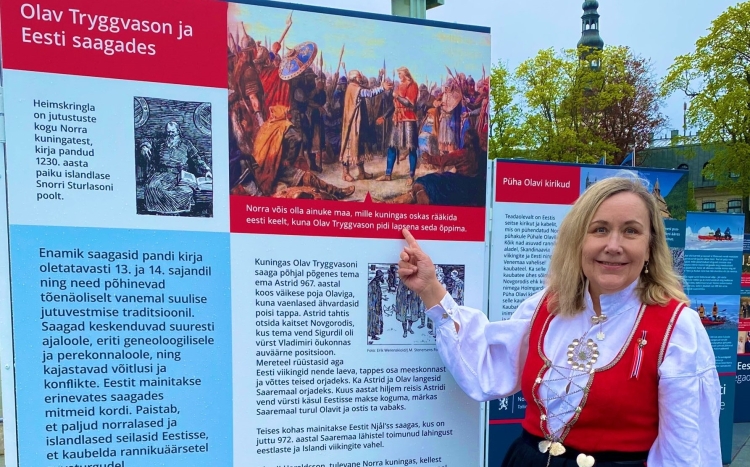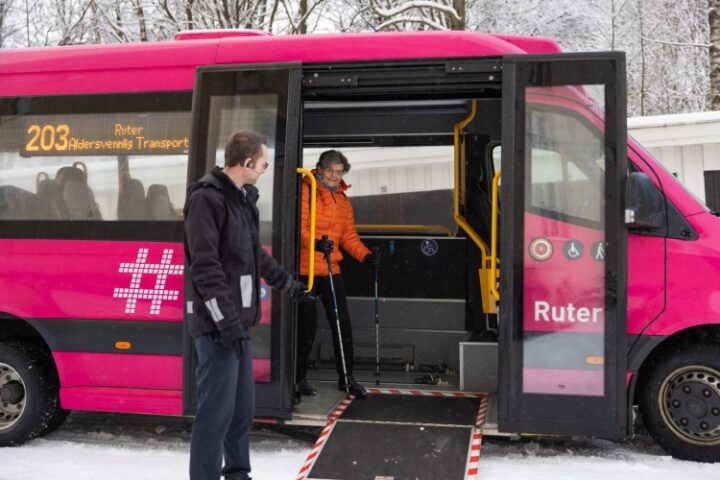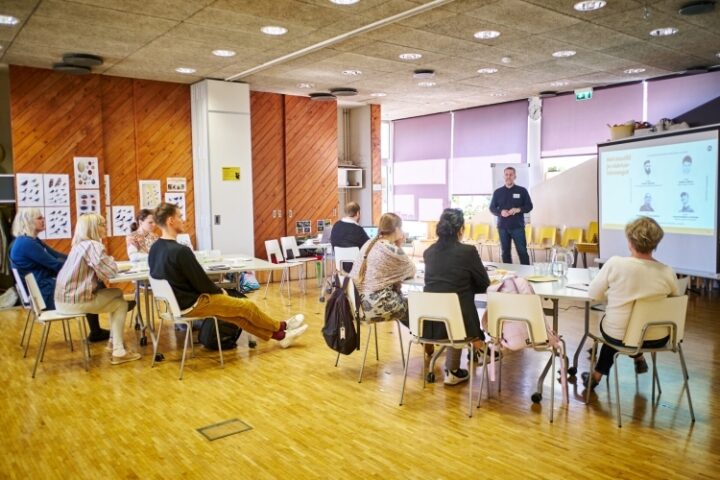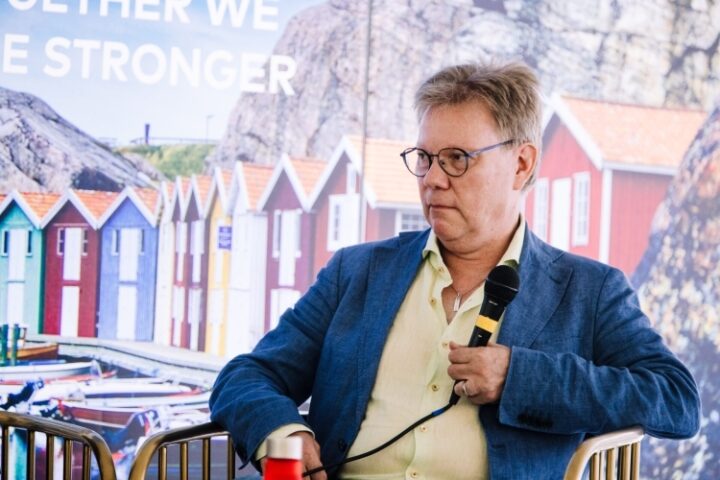Norwegian ambassador Else Berit Eikeland: Living in Estonia is a privilege! I love the nature, Pärnu, Saaremaa and… Nublu

Norway took over the presidency of the Nordic Council of Ministers (NCM) from Finland this year. To mark the occasion, we thought we would sit down with Norwegian ambassador to Estonia Else Berit Eikeland. The career diplomat, who has lived and worked in the Philippines, the United Kingdom, Canada and Ireland, is quick to declare her love for Estonia’s pristine nature and how easily accessible it is. She explores the country as much as her busy schedule of bolstering cooperation between Estonia and Norway in the fields of culture, energy and the green transition allows.
You’ve been in Estonia for a year and a half now. How are you finding it?
I knew quite a bit about Estonia before I was posted here. I’d been to Tallinn many times, but nowhere else in the country. There have been close ties between Estonia and Norway since the ’90s, when you regained your independence. Most people in Norway are aware of Estonia. Your literature has been translated into Norwegian. I read a lot, and Jaan Kross is my favourite author. People in Norway know about Buskerud and Pärnu being sister cities as well.
What surprised me here was the landscape, the nature, and how close it all is – just three hours to Narva and four to Saaremaa. I’ve been exploring the country quite a lot, its little towns and villages. That’s important for a diplomat – that you don’t just get stuck in your office.
And have you come across anything odd since you’ve been here?
In the course of my career I’ve fallen in love with every country I’ve lived in. I feel like an Estonian, being here. I even look Estonian! There’s nothing odd about the place. Quite the opposite – I consider it a real privilege to live here, and I’m very happy to be here, despite arriving in the middle of lockdown. I’m impressed by what you’ve managed to build up for yourselves in just a few decades. Estonia’s digital state is amazing. I feel very safe here, and whenever I hear a bad word said about the country or its people, I’ve already started taking it personally!
I’ve heard you like Estonian music. Who are your favourite artists?
I love Nublu. I do! I’m a big fan of rap generally. I’d love to be able to arrange for Nublu to perform in Norway. I like Estonian folk music as well. I really enjoyed the Viljandi Folk Festival.
The Nordic countries, including Norway of course, are at the forefront of green thinking and action. What areas would you say Norway has had most success in when it comes to the green transition, and why?
Norway’s a very important supplier of different types of energy on the European market. We’re world-leaders in terms of the number of electric cars on our roads – 65% of all new cars are electric. Electric transport is the future we’re striving for, since it’ll mean less pollution and fewer CO2 emissions. Norway forms part of the international electricity market and is bound very tightly to the European energy market. We export both gas and electricity to the United Kingdom and a number of EU Member States, and we ourselves buy in renewable energy from Denmark and Germany when we need it.
Here in Estonia there’s widespread public opposition to wind farms. How are things in Norway? What strides have you made on that front?
We want to work a lot more closely with Estonia on the use of offshore wind power, and share our experience of it. There are people in Norway who are against wind farms on land. But we need clean, renewable energy, and offshore wind farms could be an answer to that.
Wind power is a developing field. Wind farms are moving from the land to the sea, and as the technology improves, so the turbines are getting bigger and more powerful.
Norway’s done a lot in terms of electrifying transport. For example, all of the ferries in Oslo and between the small islands close to it run on electricity, which means no more pollution. Tests are already been run on electric planes. Which all takes time, of course, but it’s the future of transport.
We won’t be flying between Tallinn and Oslo on electric planes any time soon, but short local routes could be served by them in the not too distant future. We ought to be working more closely together on developing clean technology. Estonia, for example, has digital competence in spades, and that’s needed in every branch of industry.
Norway is Europe’s biggest producer of hydropower and the sixth biggest in the world. What technology and strategies are behind that? Could Estonia and Norway work together on that front?
Norway stands out for its coastline, its mountains and its waterfalls, which have meant we’ve been able to harness power from water for more than a hundred years now. The technology has become a lot more efficient, and knowledge and resources have improved. Estonia doesn’t have the same options, if for no other reason than it’s so flat. A lot of the revenue from the sale of hydropower in Norway goes to the local governments, which is to say the people who live in the areas where the power’s generated, and that’s why people are more tolerant of the power stations.
What does Estonia have to learn from Norway?
I mentioned offshore wind farms, but Norway could also share its experience of using electricity to power all sorts of vehicles – cars and ferries and so on. Electric transport makes our towns and cities much cleaner. We’ve put a lot of time into clean transport. More bikes, smaller cars and fewer privately owned vehicles in big cities. Living outside of Oslo as I do, I’d find it very expensive to drive into the city in my own car, because the congestion and parking fees are so high. It makes much more sense to take the train. A lot’s been done in this regard in Estonia, too – take public transport in Tallinn, for example.
Let’s talk about energy prices, given they’re the number-one talking point in Estonia at the moment. How is the energy market in Norway regulated, and how does it guarantee more affordable electricity prices for the population?
It’s a big issue in Norway as well at the moment, since the price rise came as a shock to everyone and there was a lot of expectation on the government to step in and alleviate the situation. They set a cap on electricity prices for private houses and apartments. So if the price goes over 0.7 euros per kWh, the government covers 80% of the electricity bill. That will continue until spring. The compensation system here in Estonia is quite similar to the Norwegian model, actually.
The electricity market in Norway is private. Back in the ’70s the government decided that revenue from the sale of hydropower would go to local governments, but that oil and gas production would be state-owned.
There are generations in Estonia who remember how things were run in the Soviet era and the cutbacks that involved – that you just had to make do with less. People are half-joking that we’ve come full circle. What’s the situation like in Norway? Are the people there willing and able to get by on less?
That’s a good question, because there are parallels between our two countries’ experiences. When I was growing up, the privations of World War II were still in living memory – the lack of food especially. I’ve raised my kids to never throw food out. I myself try to make sparing use of everything I can. People in Norway have been eating less and less meat in recent years. The flipside of that, since the pandemic started, is that more and more fish is being eaten, because people have more time at home to cook.
Are Norwegians on the whole avid recyclers? Do they sort their waste and return bottles and stuff?
Norway’s been very successful where bottles are concerned – 97% of them are recycled. We have recycling machines for them in every supermarket. The deposit you pay on each bottle is pretty high in Norway, so that encourages people to recycle them. There are quite a few campaigns at the moment as well to get people to cut back on consumption and teaching them how to reuse things.
The effects of climate change are being seen in Estonia and Norway, with warmer weather and stronger winds. It’s frightening. We have to think about what we can all do to improve the situation.
I’m glad that the climate and the green transition are at the heart of cooperation between our two countries. For example, Norway is funding a programme in Estonia to help adapt to and alleviate the effects of climate change in which people are working together, among other areas, in the fields of the circular economy and the climate plans of local governments. And the biggest Norwegian support programme, Green ICT, is contributing to the green transition and digitalisation of industry.
How do you look after your own health? Do you have the same opportunities in Estonia in that regard as you do in Norway?
The great outdoors is such a big part of life for Norwegians – skiing, hiking, walking. I do go walking a lot here in Estonia, which is why I like going to Pärnu and Saaremaa, because they’re so close to nature. There are lots of things you can do outdoors in Tallinn as well, like in Nõmme, where I live. And the secret to good health for me is that whenever I cook or go to a restaurant, I always opt for fish. Fish and potatoes!
Can you get really good fish in Estonia? Where do you find it?
Of course you can! There are lots of fish shops in Tallinn, and there’s even a decent selection in your average supermarket. Estonians have this idea that you can’t get good fish here, but you can. I love herring, for example. And you can get very good Norwegian salmon and cod, so I don’t miss anything.
Describe for us what part being outside plays in raising kids in Norway. What positive impact does it have?
We aim to be outside as much as we possibly can. We have very close links to nature, just like Estonians do. Like you, we see ourselves as being little parts of nature, and that brings a certain inner peace and stability to our lives. You don’t have to be super-athletic or a mountain-climber or whatever – just take a stroll along the beach in Pärnu or something. Go outside, that’s the main thing. Get away from the hustle and bustle.
When my kids were little, we made a thing of sleeping outside. We grabbed our sleeping bags and headed for the beach or into the forest. These days people obsess about having the right equipment and supplies and whatnot, but I think that’s changing, and people are coming back to the idea of just going out and enjoying nature. And the outdoors isn’t just a place for the fit and active or those in good health – it should be accessible to everyone, including people with disabilities. A lot of attention in Norway is turned to ensuring that hiking trails and other natural sites can be used by people with special needs as well.
How can we get more people involved in working life and in society more broadly?
Firstly, I think you’re doing pretty well on that front here in Estonia. Look at, say, the Singing Revolution – the Baltic States as a whole proved capable of mobilising civil society to fight for its freedom. That’s astounding. I’m honestly in awe of Estonia – that you’ve managed to establish so much community initiative in the space of just three decades.
How much do Norwegian people generally rely on the state? Are benefits and support systems an everyday part of life?
Norway is a welfare society, and in that regard we’re very similar to Sweden, Finland, Denmark and Iceland. I’m grateful that it is, because it gives me trust in society.
But a welfare system depends on each and every person in it. Norwegians pay their taxes as they’re supposed to, because otherwise the safety net would fall out from underneath them.
Are people happy to contribute to society in order to gain from it and make it work? Vaccination is a hot potato here in Estonia, because some people aren’t willing to do their part. How are things in Norway in that regard?
To a large extent it’s about trust in government and trust in science. There’s very little anti-vaccination sentiment in Norway. There are those who can’t or won’t vaccinate for various reasons, but most people see getting inoculated as a way of protecting one another.
The whole thing’s fascinating, really. I hope in a few years’ time they do studies about what actually happened during the pandemic. At the moment my feeling is that both the Estonian and Norwegian governments have tried to get through it all in the best way possible. I suppose ‘trust’ is a keyword here, in cooperation between the Baltic States and the Nordic countries: trust in your country and trust in your government.
How have Norwegians been coping mentally in the midst of the pandemic? Have there been any problems?
The same sort of problems there have been here in Estonia. Isolation has given rise to more mental health issues, because we had even more stringent restrictions in Norway than you had here. While Estonia was more or less open last spring, all the restaurants in Norway were closed and the rules were all much stricter. The problems have hit the younger generation hardest. Now that the country has opened up again, we have to involve people more and offer them help.
Any final thoughts?
Estonia and Norway may be in different places right now, but we’re both Northern European countries, and we’re very similar in terms of the way we think. I really hope the friendship and solidarity we share continue for a long time to come and that we can find ways of working together to make the world a better place. That’s why it’s so exciting being the Norwegian ambassador to Estonia!
In cooperation with the news portal Geenius, the Norwegian embassy in Estonia and other Nordic embassies in the country, we launched a series of articles in which we shed light on the Nordic economies of the future and cooperation between Estonia and its Nordic neighbours. The articles can be found online at https://ari.geenius.ee/blogi/pohjamaade-tulevikumajanduse-blogi/.


